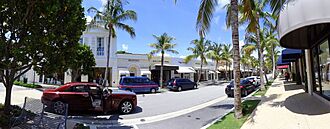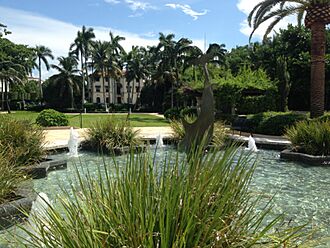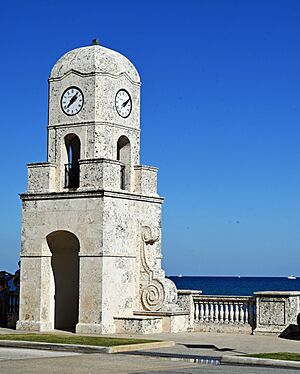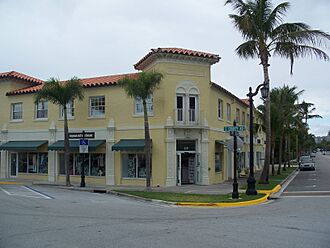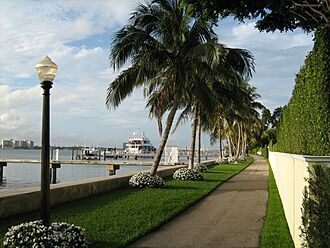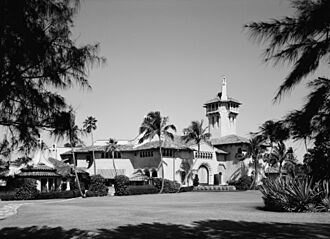Palm Beach, Florida facts for kids
Quick facts for kids
Palm Beach, Florida
|
|||
|---|---|---|---|
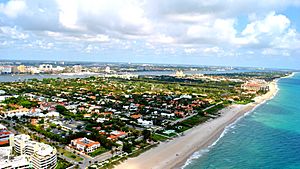
Palm Beach in 2011
|
|||
|
|||
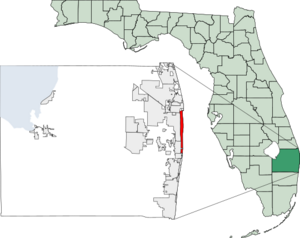
Location in Palm Beach County and the state of Florida
|
|||
| Country | United States | ||
| State | Florida | ||
| County | Palm Beach | ||
| Settled (Lake Worth Settlement) | c. 1872 | ||
| Settled (Palm Beach Settlement) | January 9, 1878 | ||
| Incorporated (Town of Palm Beach) | April 17, 1911 | ||
| Government | |||
| • Type | Council–Manager | ||
| Area | |||
| • Total | 7.80 sq mi (20.21 km2) | ||
| • Land | 3.80 sq mi (9.84 km2) | ||
| • Water | 4.00 sq mi (10.37 km2) | ||
| Elevation | 7 ft (2 m) | ||
| Population
(2020)
|
|||
| • Total | 9,245 | ||
| • Estimate
(2022)
|
9,235 | ||
| • Density | 2,430.26/sq mi (938.52/km2) | ||
| Time zone | UTC-5 (Eastern (EST)) | ||
| • Summer (DST) | UTC-4 (EDT) | ||
| ZIP Code |
33480
|
||
| Area code(s) | 561, 728 | ||
| FIPS code | 12-54025 | ||
| GNIS feature ID | 288390 | ||
Palm Beach is a special town in Palm Beach County, Florida, United States. It's located on a narrow strip of land called a barrier island. This island is separated from West Palm Beach and Lake Worth Beach by a waterway called the Intracoastal Waterway.
Palm Beach is known as a fancy winter resort for wealthy people. Many famous individuals, including former United States presidents, have lived here. The town is also famous for its high-end shopping areas like Worth Avenue. In 2020, about 9,245 people lived in Palm Beach year-round.
Contents
- History of Palm Beach
- What is Palm Beach Like?
- People of Palm Beach
- Economy and Shopping
- Arts and Fun Things to Do
- Attractions to Visit
- Parks and Outdoor Activities
- Education in Palm Beach
- Media and News
- Protecting Historic Places
- Getting Around Palm Beach
- Emergency Services
- Utilities and Services
- Famous People of Palm Beach
- See also
History of Palm Beach
Palm Beach has a rich history, starting long before it became a famous resort.
Early Days and Settlers
About 3,000 years ago, the Jaega people lived on the land that is now Palm Beach. Later, between 1816 and 1858, the Seminole people were moved out of the area. American settlers began to arrive around 1872. They even opened a post office five years later.
How Henry Flagler Built Palm Beach
A very important person in Palm Beach's history was Henry Flagler, a rich businessman. He helped turn the island from jungles and swamps into a popular winter getaway. Flagler built the Florida East Coast Railway to reach the area by 1894.
He also built two famous hotels: the Royal Poinciana Hotel in 1894 and The Breakers in 1896. In 1902, Flagler built his own grand home called Whitehall. To house the many workers for his hotels, Flagler developed a separate city, which later became West Palm Beach. The town of Palm Beach officially became a town on April 17, 1911.
Addison Mizner's Contributions
Another important person was Addison Mizner, a famous architect. Between 1919 and 1924, he designed many buildings in Palm Beach. These included the Everglades Club and a shopping area called Via Mizner on Worth Avenue.
The Styx Community
In the early 1900s, many workers, especially Black residents, lived in an area called the Styx. They rented small homes from landowners. Eventually, these residents moved to West Palm Beach, Florida, and the houses were removed.
What is Palm Beach Like?
Palm Beach is the easternmost town in Florida. It sits on a long barrier island that is about 16 miles (26 km) long.
Land and Water
The town covers about 10.4 square miles (27 km²). A large part of this area, about 6.5 square miles (17 km²), is water. The land area is about 3.9 square miles (10 km²).
Palm Beach Weather
Palm Beach has a tropical rainforest climate. This means it's warm all year round and doesn't have a dry season.
Summers, from May to October, are wet. There are often thunderstorms and tropical rains. High temperatures are usually between 86 to 90 °F (30 to 32 °C). Lows are around 70 to 75 °F (21 to 24 °C).
Winters are drier, sunnier, and less humid. High temperatures are typically 75 to 82 °F (24 to 28 °C). Lows are 57 to 66 °F (14 to 19 °C). Sometimes, it can get a bit cooler, but it's usually mild.
The town gets about 61 inches (1,500 mm) of rain each year. Most of this rain falls in the summer. Palm Beach also enjoys more than 2,900 hours of sunshine every year!
| Climate data for Palm Beach | |||||||||||||
|---|---|---|---|---|---|---|---|---|---|---|---|---|---|
| Month | Jan | Feb | Mar | Apr | May | Jun | Jul | Aug | Sep | Oct | Nov | Dec | Year |
| Record high °F (°C) | 89 (32) |
90 (32) |
94 (34) |
99 (37) |
51 (11) |
98 (37) |
101 (38) |
98 (37) |
97 (36) |
95 (35) |
91 (33) |
90 (32) |
101 (38) |
| Mean daily maximum °F (°C) | 75.1 (23.9) |
76.3 (24.6) |
79.2 (26.2) |
82.1 (27.8) |
85.9 (29.9) |
88.5 (31.4) |
90.1 (32.3) |
90.1 (32.3) |
88.7 (31.5) |
85.0 (29.4) |
80.4 (26.9) |
76.4 (24.7) |
83.1 (28.4) |
| Mean daily minimum °F (°C) | 57.3 (14.1) |
58.2 (14.6) |
61.9 (16.6) |
65.4 (18.6) |
70.5 (21.4) |
73.8 (23.2) |
75.0 (23.9) |
75.4 (24.1) |
74.7 (23.7) |
71.2 (21.8) |
65.8 (18.8) |
60.1 (15.6) |
67.4 (19.7) |
| Record low °F (°C) | 27 (−3) |
32 (0) |
30 (−1) |
43 (6) |
— | 61 (16) |
66 (19) |
65 (18) |
66 (19) |
46 (8) |
36 (2) |
28 (−2) |
27 (−3) |
| Average precipitation inches (mm) | 3.75 (95) |
2.55 (65) |
3.68 (93) |
3.57 (91) |
5.39 (137) |
7.58 (193) |
5.97 (152) |
6.65 (169) |
8.10 (206) |
5.46 (139) |
5.55 (141) |
3.14 (80) |
61.39 (1,561) |
| Source: National Weather Service | |||||||||||||
People of Palm Beach
The number of people living in Palm Beach changes throughout the year.
Population Changes
| Historical population | |||
|---|---|---|---|
| Census | Pop. | %± | |
| 1920 | 1,135 | — | |
| 1930 | 1,707 | 50.4% | |
| 1940 | 3,747 | 119.5% | |
| 1950 | 3,886 | 3.7% | |
| 1960 | 6,055 | 55.8% | |
| 1970 | 9,086 | 50.1% | |
| 1980 | 9,729 | 7.1% | |
| 1990 | 9,814 | 0.9% | |
| 2000 | 10,468 | 6.7% | |
| 2010 | 8,348 | −20.3% | |
| 2020 | 9,245 | 10.7% | |
| 2023 (est.) | 9,258 | 10.9% | |
| U.S. Decennial Census 1920–1970 1980 1990 2000 2010 2020 2023 |
|||
In 2020, Palm Beach had a year-round population of 9,245 people. However, during the "winter season" (November to April), the population grows to about 25,000. This is because many people come to Palm Beach for vacation during the colder months.
Wealth and Diversity
Palm Beach is known for being a very wealthy place. In 2017, Forbes magazine reported that over 30 billionaires lived in the town.
Most residents in Palm Beach are White. The town also has smaller groups of Hispanic or Latino, Asian, and Black or African American residents. English is the main language spoken at home.
Economy and Shopping
Palm Beach has a strong economy, especially in tourism and luxury services.
Jobs in Palm Beach
In 2018, about 2,788 people worked in Palm Beach. Many jobs are in finance, insurance, real estate, and professional services. However, most people who work in Palm Beach actually live in nearby cities like West Palm Beach.
Tourism and Famous Shopping Areas
Tourism is a huge part of Palm Beach's economy. It brings in about $5 billion every year! The town has many fancy hotels, like The Breakers, which employs over 2,200 people.
Palm Beach is famous for its upscale shopping. Worth Avenue is a well-known street with about 250 high-end shops, boutiques, restaurants, and art galleries. Other popular shopping spots include Royal Poinciana Plaza and the Royal Poinciana Way Historic District.
Arts and Fun Things to Do
Palm Beach offers many cultural and recreational activities.
The Society of the Four Arts
The Society of the Four Arts is a special place that opened in 1936. It has an art gallery, a concert hall, and two libraries. One library is just for kids, and the other is for everyone. The Society also has a lovely botanical garden and a sculpture garden.
Entertainment Venues
The Royal Poinciana Playhouse used to host ballets and plays. It closed in 2004 but is being renovated and is expected to reopen in 2024. Worth Avenue also has several art galleries where you can see beautiful artworks. The Norton Museum of Art is just across the water in West Palm Beach.
Events and Festivals
Palm Beach hosts various events. The Race of Hope to Defeat Depression is an annual run/walk that raises money for depression research. The Palm Beach International Film Festival used to take place here, but it's currently on hold. Worth Avenue also has historical walking tours.
Attractions to Visit
Palm Beach has several interesting places to explore.
Flagler Museum (Whitehall)
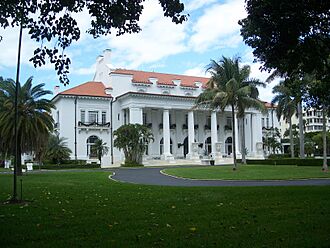
Whitehall was once Henry Flagler's grand home. It reopened as the Flagler Museum in 1960. You can visit to see how the house looked originally and learn about Flagler's life. The museum also displays his personal railcar and tells the story of the Florida East Coast Railway. Nearly 100,000 people visit the museum each year.
Pan's Garden
The Preservation Foundation of Palm Beach created Pan's Garden in 1994. This garden features a statue of Pan, the ancient Greek god of nature. It also has a unique tile wall from the 1920s and many rare native plants.
Bethesda-by-the-Sea Church
Bethesda-by-the-Sea is the oldest church in Palm Beach, first built in 1889. The current church opened in 1926. It's a beautiful historic building.
Other Interesting Spots
- Major Alley: This alley has six charming Georgian-style cottages built in the 1920s.
- Royal Poinciana Chapel: Built by Henry Flagler in 1897, this chapel was for guests at his hotels.
- Seagull Cottage: This is the oldest surviving home in Palm Beach, built in 1886. Henry Flagler lived here before Whitehall was finished.
- Addison Mizner Memorial Fountain: This fountain was built by architect Addison Mizner in 1929. It's a beautiful landmark in the town.
Parks and Outdoor Activities
Palm Beach has many places for outdoor fun and relaxation.
Public Recreation Facilities
The town's Recreation Department manages several public spots. These include the Morton and Barbara Mandel Recreation Center and the Palm Beach Docks. The Palm Beach Docks is the only public marina in town, with many boat slips.
Beaches and Parks
Palm Beach has three public beaches: Palm Beach Municipal Beach (also called Midtown Beach), Phipps Ocean Park, and R. G. Kreusler Park. Phipps Ocean Park is home to the Little Red Schoolhouse, the first school building in southeast Florida. The town also has many private beaches.
Trails for Biking and Walking
There are three main paths for biking and walking. The Lake Trail is a 4.7-mile (7.6 km) path along the Intracoastal Waterway. There are also paths along North County Road and State Road A1A.
Clubs and Resorts
Palm Beach has several private clubs, including the Everglades Club and Mar-a-Lago. The Everglades Club, built in 1918, is a very exclusive private club with a golf course and tennis courts.
Mar-a-Lago is a large mansion built between 1924 and 1927. It was once owned by Marjorie Merriweather Post, a famous heiress. In 1985, Donald Trump bought Mar-a-Lago. He later used it as a "Winter White House" during his presidency.
Education in Palm Beach
Palm Beach has schools for younger students, and colleges are nearby.
Local Schools
The School District of Palm Beach County operates one public school in town: Palm Beach Public Elementary School. It opened in 1929 and serves elementary students. Palm Beach Day Academy is a private school with a campus in Palm Beach.
For middle school, most public school students go to Conniston Community Middle School or Lake Worth Middle School in nearby West Palm Beach. High school students attend Palm Beach Gardens Community High School or Forest Hill Community High School.
Colleges and Universities
There are no colleges directly in Palm Beach. However, nearby cities like Lake Worth Beach and West Palm Beach have several higher education options. These include Keiser University, Palm Beach Atlantic University, and Palm Beach State College.
Media and News
Palm Beach has its own local newspaper and is part of a larger media market.
Local Newspapers
The town is served by the Palm Beach Daily News, which publishes daily. It's also known as "The Shiny Sheet" because of its glossy paper. Another newspaper, The Palm Beach Post, is published in West Palm Beach but serves Palm Beach residents too.
Television and Radio
Palm Beach is part of the West Palm Beach–Fort Pierce television market. This means residents can watch many TV channels affiliated with major networks like NBC, CBS, ABC, and FOX. Several radio stations also broadcast from or are within range of the town.
Protecting Historic Places
Palm Beach works to protect its historic buildings and unique look.
Preservation Efforts
The Landmarks Preservation Commission (LPC) was created in 1979 to study and protect historic structures. They have a list of over 300 properties they work to preserve. The Preservation Foundation of Palm Beach also helps protect the town's architectural and cultural heritage.
National Historic Places
Thirteen buildings and one historic district in Palm Beach are listed on the National Register of Historic Places. This is a special list of places important to the history of the United States.
Getting Around Palm Beach
Palm Beach is connected to other areas by bridges and roads.
Bridges to West Palm Beach
Three bridges connect Palm Beach to West Palm Beach across the Intracoastal Waterway. These are the Flagler Memorial Bridge, the Royal Palm Bridge, and the Southern Boulevard Bridge. All of these bridges have been rebuilt or renovated in recent years.
Roads and Highways
State Road A1A runs through much of Palm Beach. The town does not have any major interstate highways, but Interstate 95 passes through nearby West Palm Beach. Most people in Palm Beach use private cars or taxis to get around.
Public Transportation and Airports
The Palm Beach International Airport is about 4.5 miles (7.2 km) east of Palm Beach. The town also has some public bus service provided by Palm Tran. West Palm Beach has train stations for Tri-Rail, Amtrak, and Brightline (a higher-speed rail service).
Emergency Services
Palm Beach has its own police and fire departments to keep residents safe.
Police Department
The Palm Beach Police Department was started in 1922. Before that, a town marshal was in charge of law enforcement. The department has many officers who work to keep the town safe.
Firefighting Services
In the early days, West Palm Beach helped Palm Beach with fires. But in 1921, Palm Beach created its own fire-rescue department. Today, the Palm Beach Fire Rescue has three stations and many employees. They respond to thousands of calls each year.
Utilities and Services
The town provides important services like electricity, water, and waste collection.
Electricity
Florida Power & Light (FPL) provides electricity to Palm Beach. Most of their power comes from natural gas and nuclear energy. The town is also working on a big project to bury electrical lines underground, which helps protect them from storms.
Water and Sewage
The town government manages the sewage systems. Wastewater is collected and sent to a treatment facility in West Palm Beach. Tap water for Palm Beach has been supplied by the city of West Palm Beach since 1955.
Recycling and Garbage
Palm Beach also provides recycling and garbage collection services. Recyclables and trash are taken to special facilities in West Palm Beach.
Famous People of Palm Beach
Palm Beach is home to many well-known individuals, both full-time and part-time residents.
Before Henry Flagler arrived, some notable people already lived here, like businessman Louis Semple Clarke. Two United States Presidents have been part-time residents: John F. Kennedy and Donald Trump. Both used their Palm Beach homes as a "Winter White House."
Kennedy's home was called La Querida. Donald Trump has owned Mar-a-Lago since 1985. After his presidency, Donald and Melania Trump made Mar-a-Lago their main home. Former Canadian prime minister Brian Mulroney also lived in Palm Beach for many years.
See also
 In Spanish: Palm Beach (Florida) para niños
In Spanish: Palm Beach (Florida) para niños




